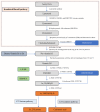Vitamin D: recent advances, associated factors, and its role in combating non-communicable diseases
- PMID: 40514375
- PMCID: PMC12166060
- DOI: 10.1038/s41538-025-00460-5
Vitamin D: recent advances, associated factors, and its role in combating non-communicable diseases
Abstract
The field of nutrigenomics has produced numerous studies indicating the impact of vitamin D on various disease conditions. Trace elements of this vitamin in the body play a significant role in the regulation of body metabolism. This immunomodulatory vitamin plays a role in management of both communicable (viz. respiratory illness like COVID-19 and Respiratory tract infections) and non-communicable diseases e.g., cancer, osteomalacia, diabetes, and cardiovascular diseases. Deficient levels, i.e., vitamin D deficiency in body can lead to the onset of chronic non-communicable illnesses. Vitamin D plays a direct and sometimes indirect role in the progression (when deficient) and prevention (when sufficient) of non-communicable diseases. This essential nutrient may be obtained through dietary intake or supplements. However, the absorption of it relies on various factors, including the presence of complementary nutrients, chemical forms, and external stimuli such as UV-B and a healthy gastrointestinal tract. This review discusses vitamin D absorption and its role in non-communicable diseases with updates on methods for evaluating and fortifying this vitamin in varied diets. We also briefly highlight recommended dietary allowances by age group, absorption difficulties, and its significance in non-communicable disorders.
© 2025. The Author(s).
Conflict of interest statement
Competing interests: The authors declare no competing interests. Ethical approval and consent to participate: Not applicable. This article does not contain any studies with human participants or animals that are performed by any of the authors.
Figures




Similar articles
-
Clinical utility of vitamin d testing: an evidence-based analysis.Ont Health Technol Assess Ser. 2010;10(2):1-93. Epub 2010 Feb 1. Ont Health Technol Assess Ser. 2010. PMID: 23074397 Free PMC article.
-
A Prospective Study to Evaluate the Possible Role of Cholecalciferol Supplementation on Autoimmunity in Hashimoto's Thyroiditis.J Assoc Physicians India. 2023 Jan;71(1):1. J Assoc Physicians India. 2023. PMID: 37116030 Clinical Trial.
-
Interplay of Vitamin D and SIRT1 in Tissue-Specific Metabolism-Potential Roles in Prevention and Treatment of Non-Communicable Diseases Including Cancer.Int J Mol Sci. 2023 Mar 24;24(7):6154. doi: 10.3390/ijms24076154. Int J Mol Sci. 2023. PMID: 37047134 Free PMC article. Review.
-
Dietary glycation compounds - implications for human health.Crit Rev Toxicol. 2024 Sep;54(8):485-617. doi: 10.1080/10408444.2024.2362985. Epub 2024 Aug 16. Crit Rev Toxicol. 2024. PMID: 39150724
-
[Changes in mineral metabolism in stage 3, 4, and 5 chronic kidney disease (not on dialysis)].Nefrologia. 2008;28 Suppl 3:67-78. Nefrologia. 2008. PMID: 19018742 Spanish.
References
-
- Liss, Y. & Frishman, W. H. Vitamin D: A cardioprotective agent?. Cardiol. Rev.20, 038–44 (2012). - PubMed
-
- Gebhardt S. E., TR, EJ, LL, & HJ. Estimation of the Vitamin D Content of Foods for the Assessment of Dietary Intake. U.-A. B. H. N. R. Center. USDA-ARS Beltsville Human Nutrition Research Center; 2009.
-
- Witham, M. D. Vitamin D in chronic heart failure. Curr. Heart Fail Rep.8, 123–30 (2011). - PubMed
-
- Pilz, S. et al. Vitamin D, cardiovascular disease and mortality. Clin. Endocrinol. (Oxf.)75, 575–84 (2011). - PubMed
Publication types
LinkOut - more resources
Full Text Sources

